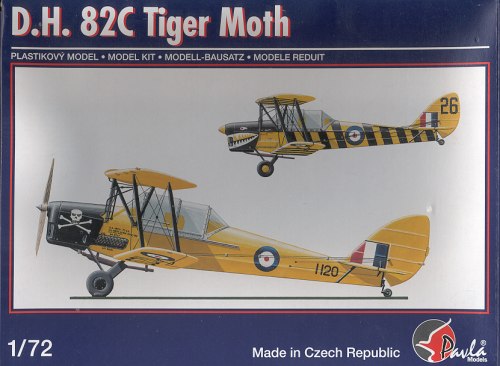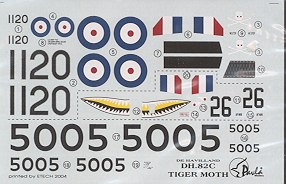
| KIT: | Pavla 1/72 Dehavilland D.H.82C Tiger Moth |
| KIT #: | 72052 |
| PRICE: | $29.98 (27.96 at Squadron) |
| DECALS: | Three options |
| REVIEWER: | Scott Van Aken |
| NOTES: | Limited Run with vac canopies and resin parts. |

| HISTORY |
This classic British trainer made its first flight on October 26, 1931. It is one of a number of models of light aircraft named for moths in recognition of designer Geoffrey de Havilland's interest in moths and butterflies. It became popular with the RAF throughout the United Kingdom as well as the civilian aviation market.
In Britain, 8,101 were manufactured plus 2,751 more in Canada, Australia, and New Zealand. During WWII, most Royal Air Force pilots trained in Tiger Moths including Americans who flew with the Eagle Squadrons before the U.S. entered the war. In the United Kingdom, Tiger Moths performed a variety of roles in addition to that of primary trainer including submarine patrol, air ambulance, and even prisoner evacuation. The U.S. Army Air Forces in 1942 ordered 200 from de Havilland of Canada as the PT-24, but these were never delivered and were diverted to the Royal Canadian Air Force instead.
Thanks to its ease of operation, robust construction and the sheer numbers built, there are a large number of these aircraft still flying around the world. Because they looked the part, Tiger Moths have played the roles of various WWI fighter aircraft in a number of movies over the decades since the last one was built.
| THE KIT |
 In
the continuing saga of Czech limited run kit companies doing up-to-date
versions of old Airfix and Frog kits we now have somewhat supplanted the
Airfix Tiger Moth that was previewed just a short time ago. I say somewhat
as this is a Canadian-built version that has a full canopy (and supposedly
some sort of heater) for use in those places where it gets down right
chilly. I should also point out that Aeroclub produces a short run Tiger
Moth that fixes the 'too far forward' cockpits of the Airfix kit. Thanks
for the additional info, John.
In
the continuing saga of Czech limited run kit companies doing up-to-date
versions of old Airfix and Frog kits we now have somewhat supplanted the
Airfix Tiger Moth that was previewed just a short time ago. I say somewhat
as this is a Canadian-built version that has a full canopy (and supposedly
some sort of heater) for use in those places where it gets down right
chilly. I should also point out that Aeroclub produces a short run Tiger
Moth that fixes the 'too far forward' cockpits of the Airfix kit. Thanks
for the additional info, John.
There is a single sprue of somewhat flashy parts that are otherwise well detailed, though there really is precious little in the way of panels, hatches and the like on the Tiggie. All the flying surfaces are a single mold and the fabric representation on them is rather well done. The interior consists of basically a floor, seats, sticks and instrument panels. The instrument panels are in resin with some circular marks on it for instrument. There are also back panels for behind the seats. No rudder pedals or any sidewall detail on this one.
 The
upper wing fuel tank is also resin as are the main wheels, engine front and
the optional skis (Canada.....cold...). You can also see that there are
what seem to be a zillion struts. The landing gear is a particularly
complex appearing assembly, but careful building should easily
overcome any complexity. There are two vacuformed canopies for those of us
who usually mess one up. Why other companies only supply one is beyond me.
It isn't as if these things are expensive to make.
The
upper wing fuel tank is also resin as are the main wheels, engine front and
the optional skis (Canada.....cold...). You can also see that there are
what seem to be a zillion struts. The landing gear is a particularly
complex appearing assembly, but careful building should easily
overcome any complexity. There are two vacuformed canopies for those of us
who usually mess one up. Why other companies only supply one is beyond me.
It isn't as if these things are expensive to make.
Instructions are much of what we have
come to expect from Pavla. The color chart gives generic and Humbrol
references and there is a small detail painting section, much like what
Matchbox used to do with their kits. The instructions do provide a few
detail and alignment drawings to help out. What is not provided is a
separate  rigging
diagram. The paint and decal pages (which take up over half the booklet)
provide side and top views of the rigged aircraft, but a front one would be
appreciated. Markings are provided for three aircraft, all of them
basically overall yellow. First one up has a black cowling with a
skull and crossbones upon it as shown on the box art. This one is from 31
EFTS in DeWinton, Canada during 1942. Next is a very gaudy one with black
stripes on the wing and black bands around the fuselage. On the black
cowling is a shark mouth. The builder will have to paint the stripes (which
are on both wings), making for a rather complex masking job, but also
making for an eye-catching model. The final on is a very standard aircraft
but this one is on skis. The decals are very well printed with no
detectable registration problems. They appear very thin and if like other
Czech decals, should work beautifully.
rigging
diagram. The paint and decal pages (which take up over half the booklet)
provide side and top views of the rigged aircraft, but a front one would be
appreciated. Markings are provided for three aircraft, all of them
basically overall yellow. First one up has a black cowling with a
skull and crossbones upon it as shown on the box art. This one is from 31
EFTS in DeWinton, Canada during 1942. Next is a very gaudy one with black
stripes on the wing and black bands around the fuselage. On the black
cowling is a shark mouth. The builder will have to paint the stripes (which
are on both wings), making for a rather complex masking job, but also
making for an eye-catching model. The final on is a very standard aircraft
but this one is on skis. The decals are very well printed with no
detectable registration problems. They appear very thin and if like other
Czech decals, should work beautifully.
| CONCLUSIONS |
I do have to say that this one is quite an improvement over the old Airfix kit. Since it is a biplane and 1/72, it will take someone with a bit of experience to get this one just right, but the vast majority of modelers should be able to tackle it without any real problems.
You can find this kit and many others at

If you would like your product reviewed fairly and quickly by a site that has nearly 300,000 visitors a month, please contact me or see other details in the Note to Contributors.